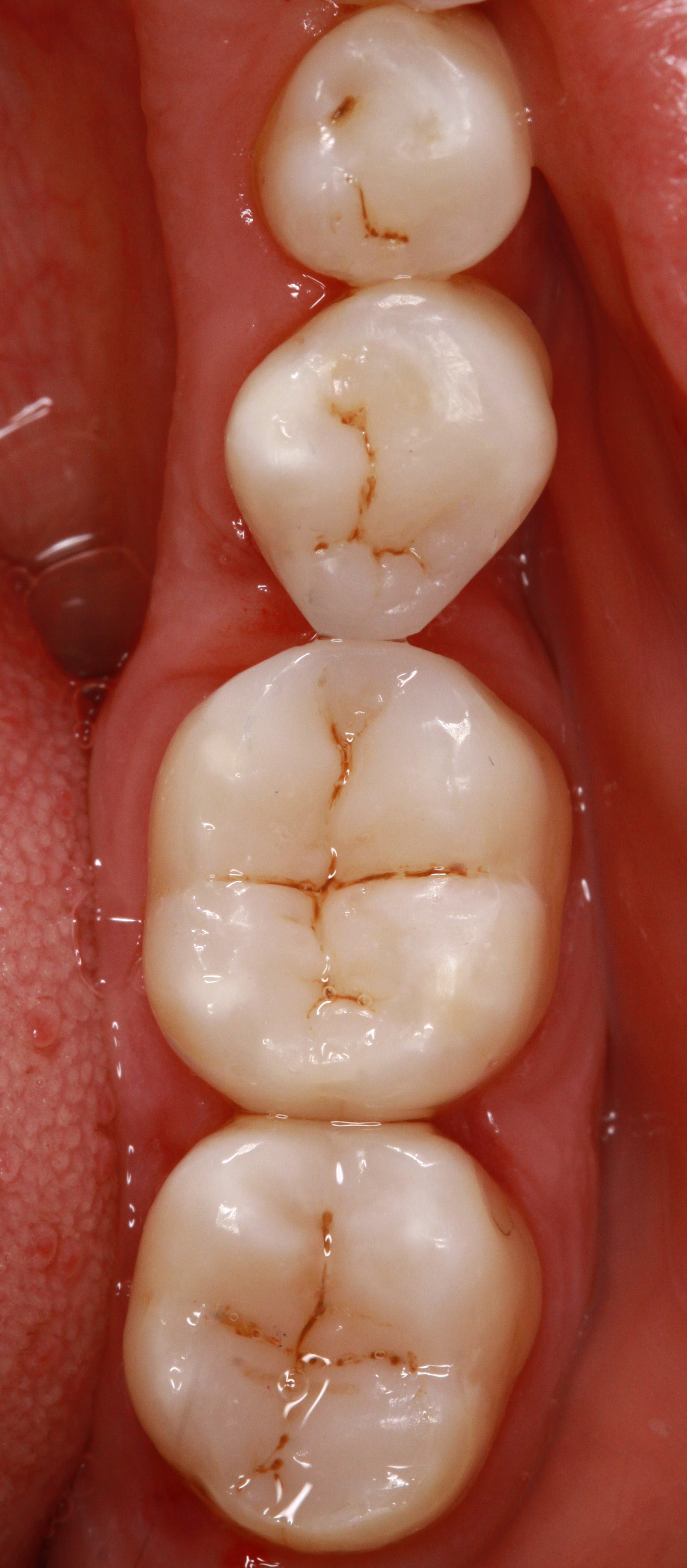Kombinierter, festsitzend-herausnehmbarer Zahnersatz
Kombinierter, festsitzend-herausnehmbarer Zahnersatz ist Teil der Prothetik. Im Gegensatz zu Totalzahnersatz (Vollprothesen, Totalprothesen) sind dabei stets noch eigene Zähne und/oder Implantate vorhanden. Anders als rein herausnehmbarer Zahnersatz (dazu gehören totale und nur mit Klammern an natürlichen Zähnen verankerte Prothesen) besteht der f.h.Z. aus einer Kombination von zwei Komponenten, einerseits festsitzender, andererseits herausnehmbarer Zahnersatz.
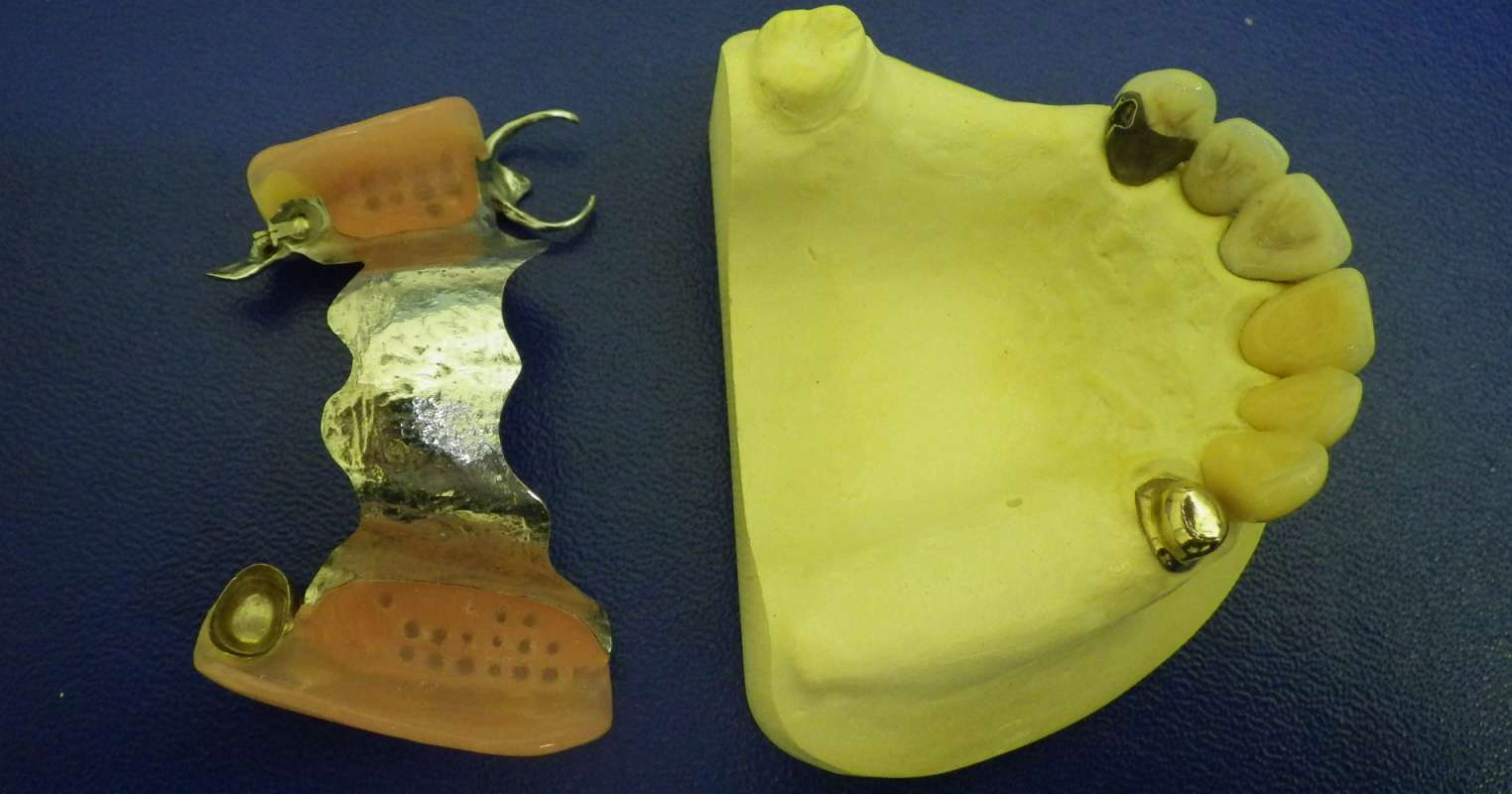 Kombi-ZE mit Modellguss, Klammer, Geschiebe und Doppelkrone (Demonstrationsmodell)
Kombi-ZE mit Modellguss, Klammer, Geschiebe und Doppelkrone (Demonstrationsmodell)
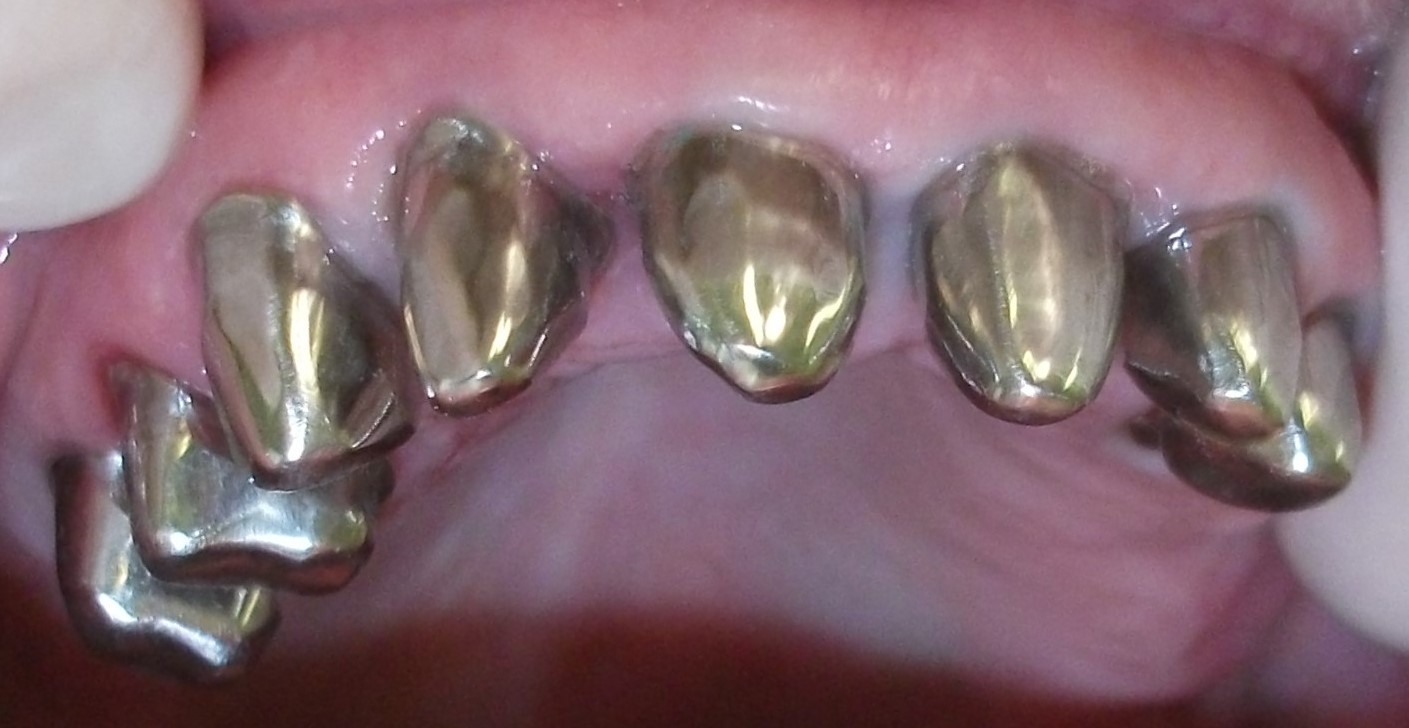 Festsitzender Anteil (Konuskronen, primär)
Festsitzender Anteil (Konuskronen, primär)
Auf dem parodontal getragenen, festsitzenden Zahnersatz-Anteil, meist in Form von Einzel- oder Brückenpfeilerkronen auf Zähnen oder Implantaten oder speziellen Implantatpfosten (Abutments) ist der vom Patienten herausnehmbare Anteil mit Halte- und Verbindungselementen (z.B. Klammern, Geschiebe, Doppelkronen, Druckknopfsysteme, Magnete u.a.) verankert.
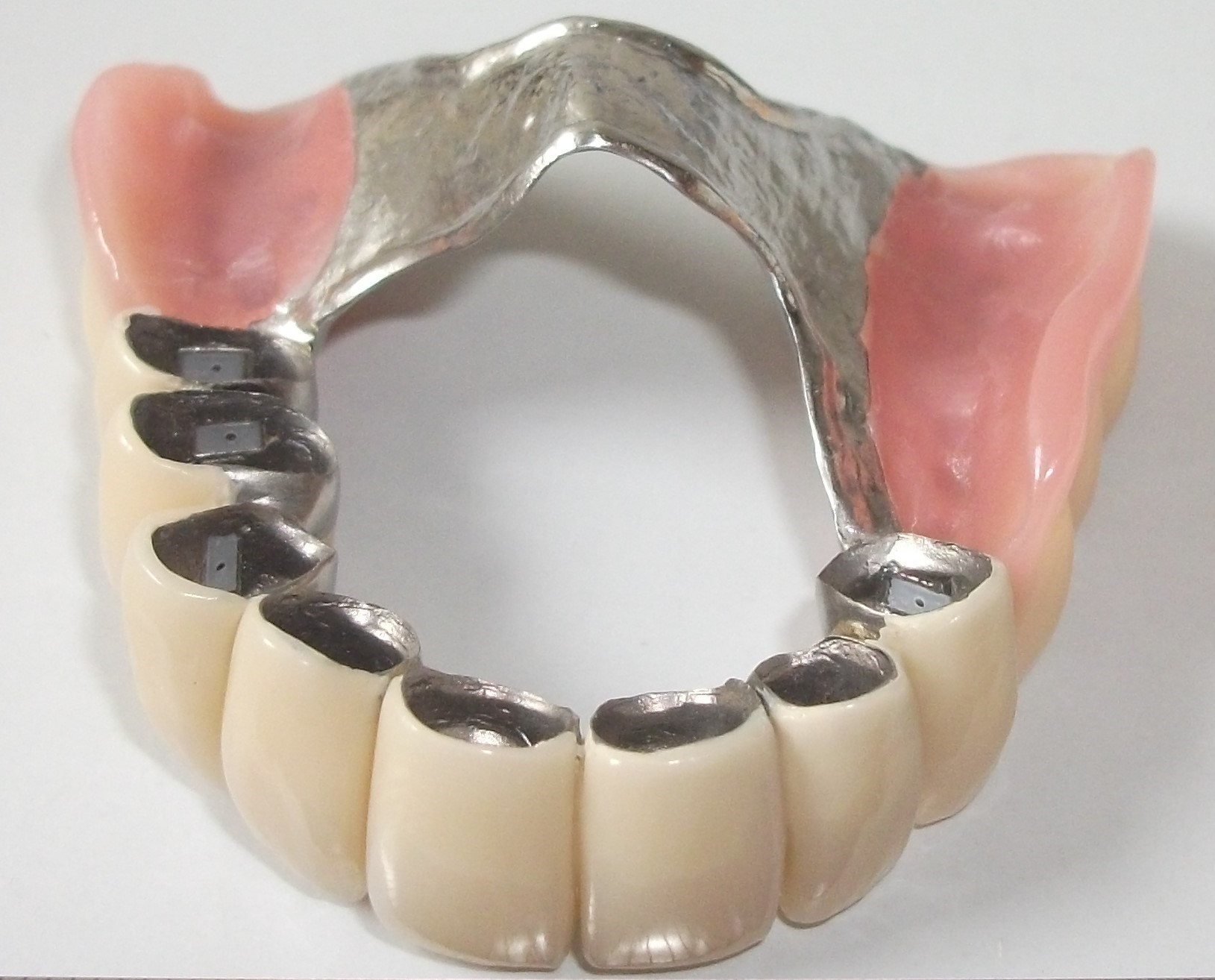 Herausnehmbare Teilprothese (Sekundär)
Herausnehmbare Teilprothese (Sekundär)
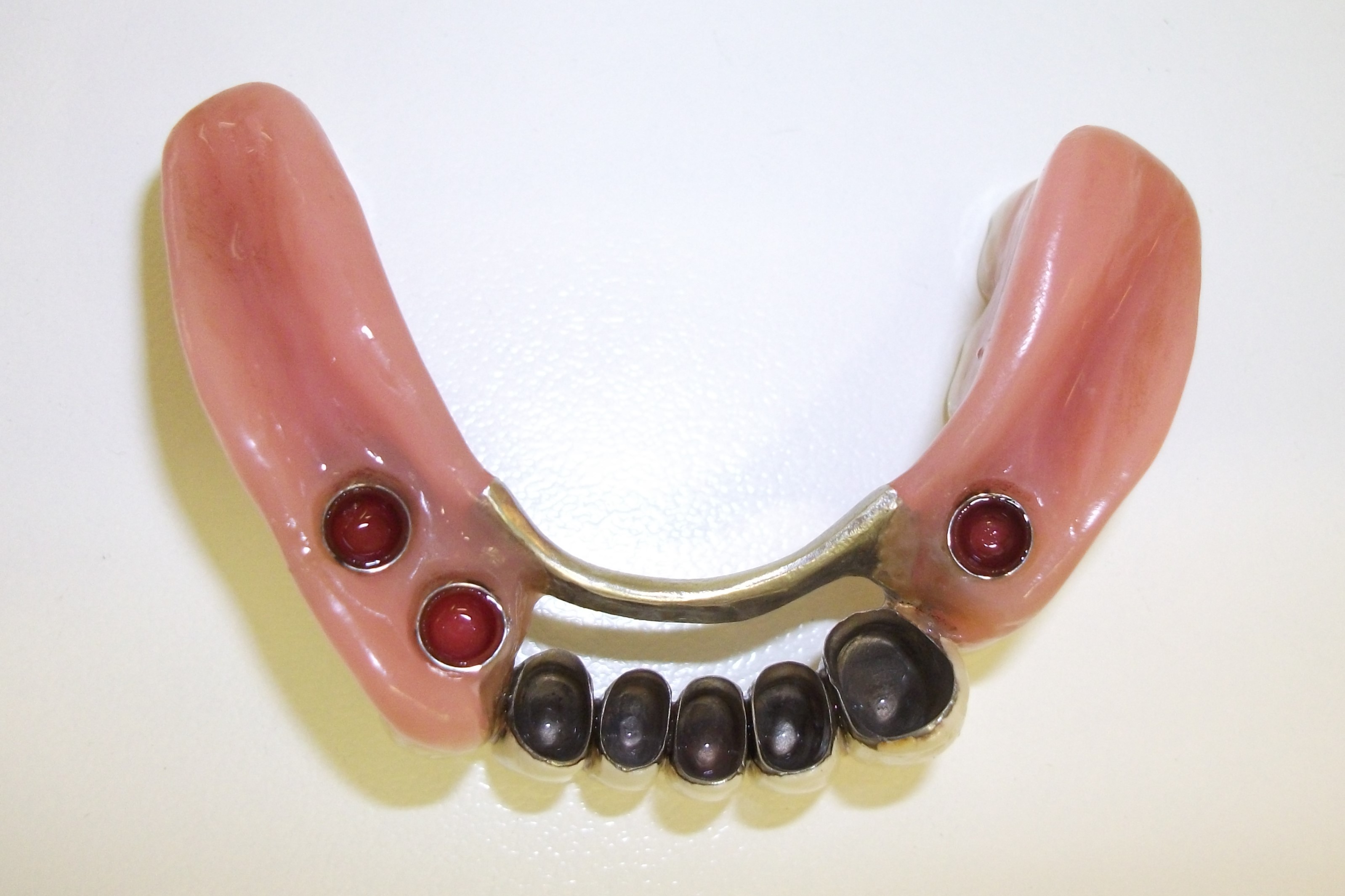 Unterkieferteilprothese, herausnehmbar
Unterkieferteilprothese, herausnehmbar
Die herausnehmbare Brücke (meist als "teleskopierende Brücke" von Doppelkronen getragen) ersetzt Zähne durch Brückenglieder und kommt fast stets ohne Schleimhautbedeckung aus.
Andere Formen von F.h.Z. beinhalten stets auch die Schleimhaut bedeckende, auf ihr abgestützte und sie mit Druck belastende Anteile. Eine Cover-Denture-Prothese überdeckt dabei alle Verbindungselemente vollständig und entspricht zahnseitig einer Totalprothese. Der den harten Gaumen im Oberkiefer abdeckende Bereich von f.h.Z. wird als Gaumenplatte bezeichnet, ein Anteil auf dem unbezahnten Kieferkamm als Sattel. Mehrere Sättel von f.h.Z. eines Kiefers werden oft durch eine Metallbasis verbunden, im Oberkiefer etwa durch große Verbinder (Transversalband), im Unterkiefer durch Unterzungenbügel. F.h.Z. kann aber auch vollständig metallfrei gefertigt werden. Fehlende Zähne sind meist durch konfektionierte Prothesenzähne aus Kunststoff ersetzt, seltener (historisch häufiger) auch durch vorgefertigte Keramikzähne.
Bei der Herstellung von f.h.Z. wird durch spezielle Abformmassen und -Verfahren versucht, ein gleichmäßiges Anliegen der Prothesenbasis am Kiefer zu erreichen. Wird die Resilienz der Schleimhaut überschritten, oder treten wiederholt Scheuerbewegungen von f.h.Z. auf, können kurzfristig Druckstellen entstehen. Nach Monaten und Jahren baut sich individuell in unterschiedlichem Ausmaß das knöcherne Prothesenlager ab (physiologische und Druck-Atrophie.) Durch Unterfütterung der Prothesenbasis kann erneut Kongruenz hergestellt werden.
F.H.Z. ermöglicht – anders als rein festsitzender Zahnersatz – Pflege- und Reparaturmaßnahmen außerhalb des Mundes. Auch Kontrolle und Hygiene der verbliebenden Zähne sind erleichtert. Bei Verlust von Stützpfeilern kann f.h.Z. in vielen Fällen erweitert werden, eine Neuanfertigung ist oft nicht erforderlich.
Eine Pfeilervermehrung durch Implantate kann bei f.h.Z. zu festerem und stabilerem Halt sowie einer Entlastung verbliebener natürlicher Zähne beitragen.
Werden durch f.h.Z. neben fehlenden Zähnen auch andere anatomische Strukturen ersetzt, handelt es sich um Epithesen.
Die Kombi- oder Hybridbrücke ist meist kein f.h.Z. sondern ein (ggf. bedingt abnehmbarer) rein festsitzender Zahnersatz auf natürlichen Zähnen und Implantaten.
Want to give it a try ...
... or need professional advice?
Get in touch with us or click Contact.
Word of the day
| English | German |
|---|---|
| single-blinded | Einzelblind |
Focus text of the month
Composites also composite (from the Latin componere = to compose) are tooth-coloured filling materials with plastic properties used in dental treatment. In lay terms they are often referred to as plastic fillings, also erroneously sometimes confused with ceramic… Composites also composite (from the Latin componere = to compose) are tooth-coloured filling materials with plastic properties used in dental treatment. In lay terms they are often referred to as plastic fillings, also erroneously sometimes confused with ceramic fillings due to their tooth colour. After being placed in a cavity they cure chemically or by irradiating with light or a combination of the two (dual-curing). Nowadays, composites are also used as luting materials. The working time can be regulated with light-curing systems, which is a great advantage both when placing fillings and during adhesive luting of restorations. Dual-curing luting materials are paste/paste systems with chemical and photosensitive initiators, which enable adequate curing, even in areas in which light curing is not guaranteed or controllable. Composites were manufactured in 1962 by mixing dimethacrylate (epoxy resin and methacrylic acid) with silanized quartz powder (Bowen 1963). Due to their characteristics (aesthetics and advantages of the adhesive technique) composite restorations are now used instead of amalgam fillings.
The material consists of three constituents: the resin matrix (organic component), the fillers (inorganic component) and the composite phase. The resin matrix mainly consists of Bis-GMA (bisphenol-A-glycidyldimethacrylate). As Bis-GMA is highly viscous, it is mixed in a different composition with shorter-chain monomers such as, e.g. TEGDMA (triethylene glycol dimethacrylate). The lower the proportion of Bis-GMA and the higher the proportion of TEGDMA, the higher the polymerisation shrinkage (Gonçalves et al. 2008). The use of Bis-GMA with TEGDMA increases the tensile strength but reduces the flexural strength (Asmussen & Peutzfeldt 1998). Monomers can be released from the filling material. Longer light-curing results in a better conversion rate (linking of the individual monomers) and therefore to reduced monomer release (Sideriou & Achilias 2005) The fillers are made of quartz, ceramic and/ or silicon dioxide. An increase in the amount of filler materials results in decreases in polymerisation shrinkage, coefficient of linear expansion and water absorption. In contrast, with an increase in the filler proportion there is a general rise in the compressive and tensile strengths, modulus of elasticity and wear resistance (Kim et al. 2002). The filler content in a composite is also determined by the shape of the fillers.
Composite restorations Conclusion |

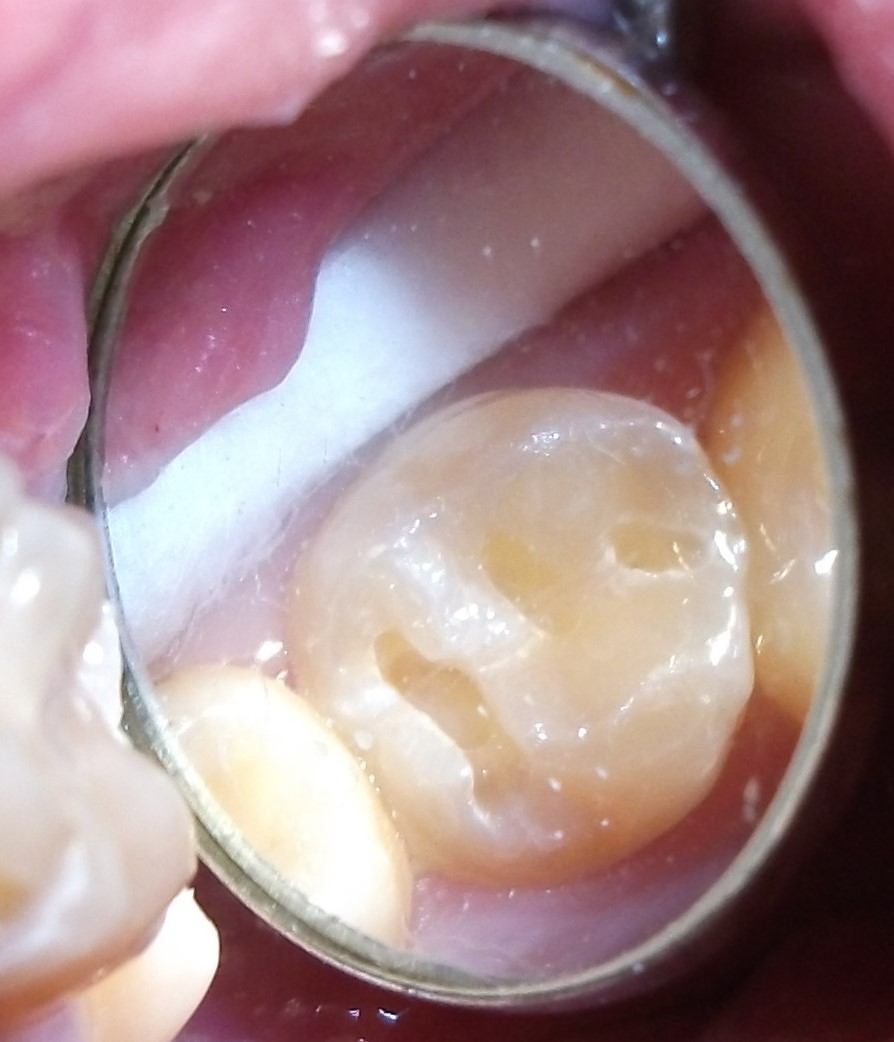 Minimally-invasive preparation and
Minimally-invasive preparation and 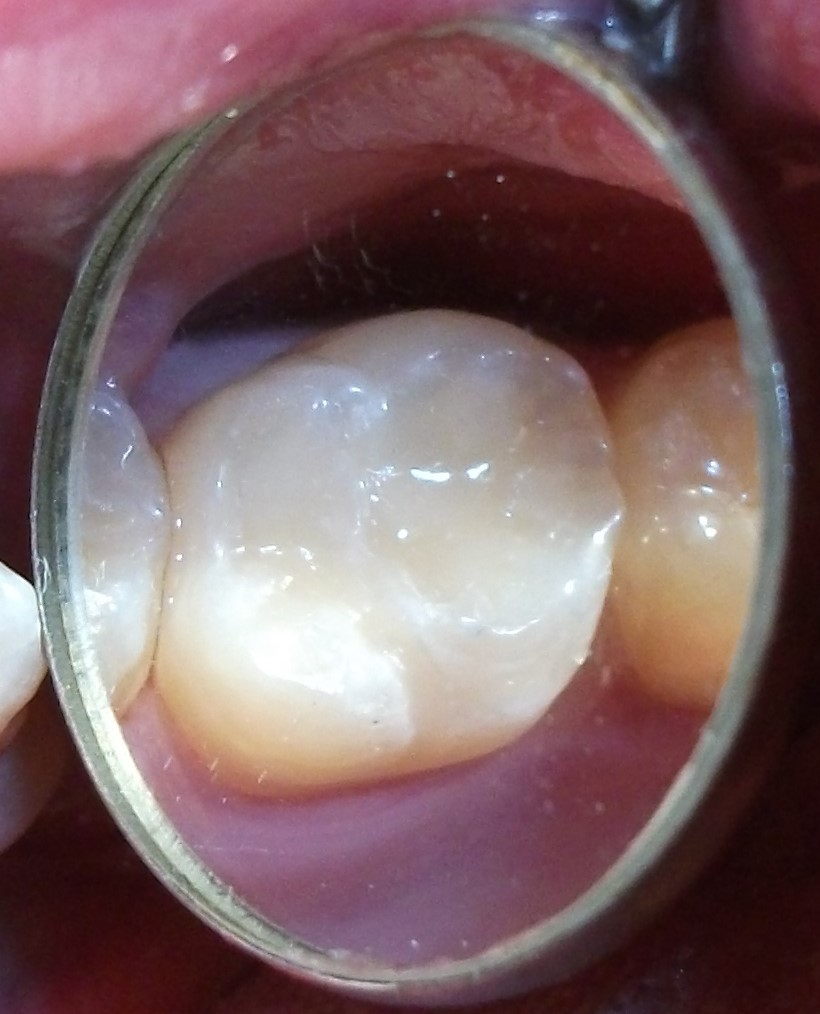 indiscernible composite restoration
indiscernible composite restoration